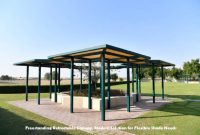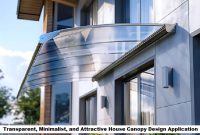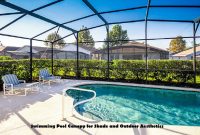The function of canopy in the construction sector are quite broad. A canopy is defined as a curtain or ceiling made of tarpaulin, fabric, metal, or other materials. A home canopy is a frame and roof generally installed in the front area of a house. Typically, canopies have poles that serve as a divider between the yard and the interior of the house.

Getting to Know the Function of Canopy
Currently, a variety of canopy models and materials are available, such as tile, shingle, vinyl, polycarbonate, fabric, plastic, concrete roofing, zinc, and fiber cement. With so many canopy options, users can customize the canopy material to their needs and tastes.
Canopies are divided into two main types, lightweight steel canopies and hollow iron canopies. In addition to providing protection, canopies are also aesthetic elements that enhance the beauty of buildings. Here are the general function of canopy to understand.
1. Building Element Protection
Originally, canopies were used by the Dutch to shade houses. European house architecture featured numerous openings to capture sunlight. Typically, building walls were constructed of a mixture of cement and brick. However, in tropical regions with high rainfall and humidity, additional protection is required. Canopies help protect buildings from wind-blown dust and maintain structural durability.
2. Reduce Light Reflection
Sunlight entering directly into a home often disrupts comfort. Reflected light can make it difficult to see a television or computer screen. Using a canopy roof can be a solution to this problem. A sturdy canopy can reduce the intensity of sunlight without darkening the home. This allows occupants to enjoy natural light without being disturbed by excessive reflection.
3. As Decoration
Canopies come in a variety of attractive and artistic designs, making them a popular decorative element. The function of canopy is to enhance the appearance of a home’s exterior. For best results, choose a canopy material that is easy to maintain, durable, and creates a unique and distinctive impression.
4. Energy Saving
Canopies also function as a barrier against excess heat inside the home. Their presence can lower the temperature, making the room feel cooler. Proper use of a canopy helps prevent direct sunlight from entering the home, creating a more comfortable environment.
Judging by the Instagram account @langgengtradateknik, canopies are one of the most functional exterior features of a home. They protect the home from various weather conditions, such as hot sun, wind, and rain. One recommended canopy material is polycarbonate. Polycarbonate canopies provide additional protection, keeping the home cool from UV rays, are strong against impacts from hard objects, and are more durable because they don’t yellow easily.
Choosing a canopy with the right material, such as curtains, can create a simple yet elegant look. Furthermore, the area under the canopy can be used to place a small table and chairs for relaxing.
Comparison of Polycarbonate Canopy vs Glass Canopy
Because canopies are still so popular today, choosing the right one can significantly increase user satisfaction. Glass canopies are quite popular due to their sleek and transparent structure. Glass itself can give a building a more elegant and modern feel. However, these canopies are prone to breaking and are also quite expensive.
Polycarbonate canopies, on the other hand, are quite affordable without sacrificing their function and advantages. Although both are transparent like glass, polycarbonate is far superior because it doesn’t break easily upon impact, as previously explained. Therefore, it’s ideal for buildings with various architectural styles.
Utilizing a canopy can reduce the use of electronic devices like fans and air conditioners. This not only saves on electricity costs but also creates a naturally cooler room. Properly using a canopy will provide extra comfort for home occupants.
The function of canopy cannot be ignored by anyone, especially those seeking extra protection. Therefore, the use of a canopy in a home must be considered carefully to ensure its optimal function. /ame



